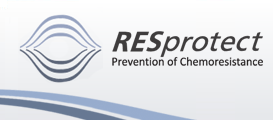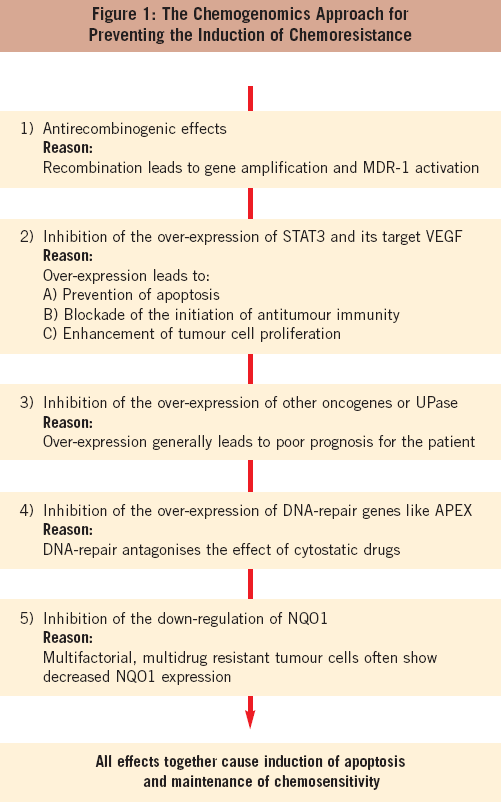| Combating Chemoresistance |

|

|

|
Page 2 of 4
Cytotoxic anticancer drugs are used in chemotherapy to destroy proliferating tumour cells. Unfortunately, repeated chemotherapeutic treatment induces or selects for chemoresistance of remaining cancer cell populations. Chemoresistant cancer cells are often characterised by altered gene expression and genomic instability because of mutation, recombination and gene amplification events. Deregulation of DNA-repair enzymes is part of this phenomenon (for example, p53 gene, BRCA1/2, UBE2N, APEX and Rad51). Furthermore, the activity of enzymes that metabolise and bioactivate drugs (for example, DHFR and NQO1) or proteins that transport cytotoxic agents (for example, gp120) is often abnormal in chemoresistant cells. Therefore, the success of cytotoxic drug treatment, which aims to eliminate tumour burden, is reduced by cellular resistance. Although manifestations of resistance are conventionally referred to as acquired or intrinsic on the basis of the initial response to the first therapy, a common feature is the development of a phenotype resistant to a variety of structurally and functionally distinct agents. In both manifestations, drug resistance is a multifactorial phenomenon involving multiple interrelated or independent mechanisms (1). In model systems, resistance is often caused by the overproduction of glycoprotein gp120, which is coded by the multi-drug resistance gene mdr1, and, in theory, targeting this single mechanism should suffice to reverse chemoresistance. Several inhibitors of gp120 have already been tested in the clinic. However first generation agents (for example, cyclosporin, verapamil) were limited due to unacceptable toxicity, whereas second generation agents (for example, valspodar, biricodar) had better tolerability but were restricted by unpredictable pharmacokinetic interactions and interactions with other transporter proteins. Third generation inhibitors (tariquidar XR9576, zosuquidar LY335979, laniquidar R101933 and ONT-093) have high potency and specificity for P-gp. Nevertheless, most resistant tumours use more than one mechanism to elude the therapy. Therefore, the use of drugs inhibiting gp120 is restricted to only a few tumours.
Level 1: The target of this level is increased recombination as: (a) a mechanism of the amplification of resistance and oncogenes, and (b of the activation of the MDR-1 gene. Mickley et al (3) demonstrated that chromosomal rearrangements with overexpression of hybrid MDR-1 mRNAs are a mechanism of acquired drug resistance. Antirecombinogenic drugs belong to different chemical classes, for example phenols, phorbol esters, base analogues and hormones. Level 2: STAT3 promotes cell survival and renders cancer cells resistant to chemotherapy. Conversely, inhibition of STAT3- signalling increases sensitivity to chemotherapeutic agents (4). Downregulation of STAT3 and its target VEGF probably leads to an increase of antitumour immunity that is reflected by the enhanced expression of LTA and LTB, tumour necrosis factor LIGHT/TNFSF-14, and natural killer cell transcript 4 (NK4, IL-32). Level 3: This involves inhibition of genes related to poor prognosis like the oncogene JUN-D or uridine phosphorylase (UPase). UPase gene expression seems to be strictly controlled by oncogenes, tumour suppressor genes and cytokines, and its activity is usually elevated in various tumour tissues. UPase is a marker of poor prognosis in several carcinoma (5). Level 4: Several genes affecting chemoresistance are linked to DNA repair, for example UBE2N and APEX. The protein complex containing UBE2N seems to be involved in the assembly of novel polyubiquitin chains for signalling in DNA repair and, through differential ubiquination of PCNA, affects resistance to DNA damage. Silencing of APEX expression by RNA interference nearly doubled the specific lysis of cells with enhanced DNA nicking (6). Inhibition of DNA repair genes like APEX1 during anticancer treatment increases chemosensitivity. Level 5: In accordance with the observation that a multifactorial multidrug resistance phenotype of tumour cells involves a decreased NQO1 expression (7), it should be beneficial for chemoresistance inhibitors to induce NQO1.
|
||||||



 Figure 1 shows selected genetic effects that contribute to chemoresistance. These effects can be stratified as follows:
Figure 1 shows selected genetic effects that contribute to chemoresistance. These effects can be stratified as follows: